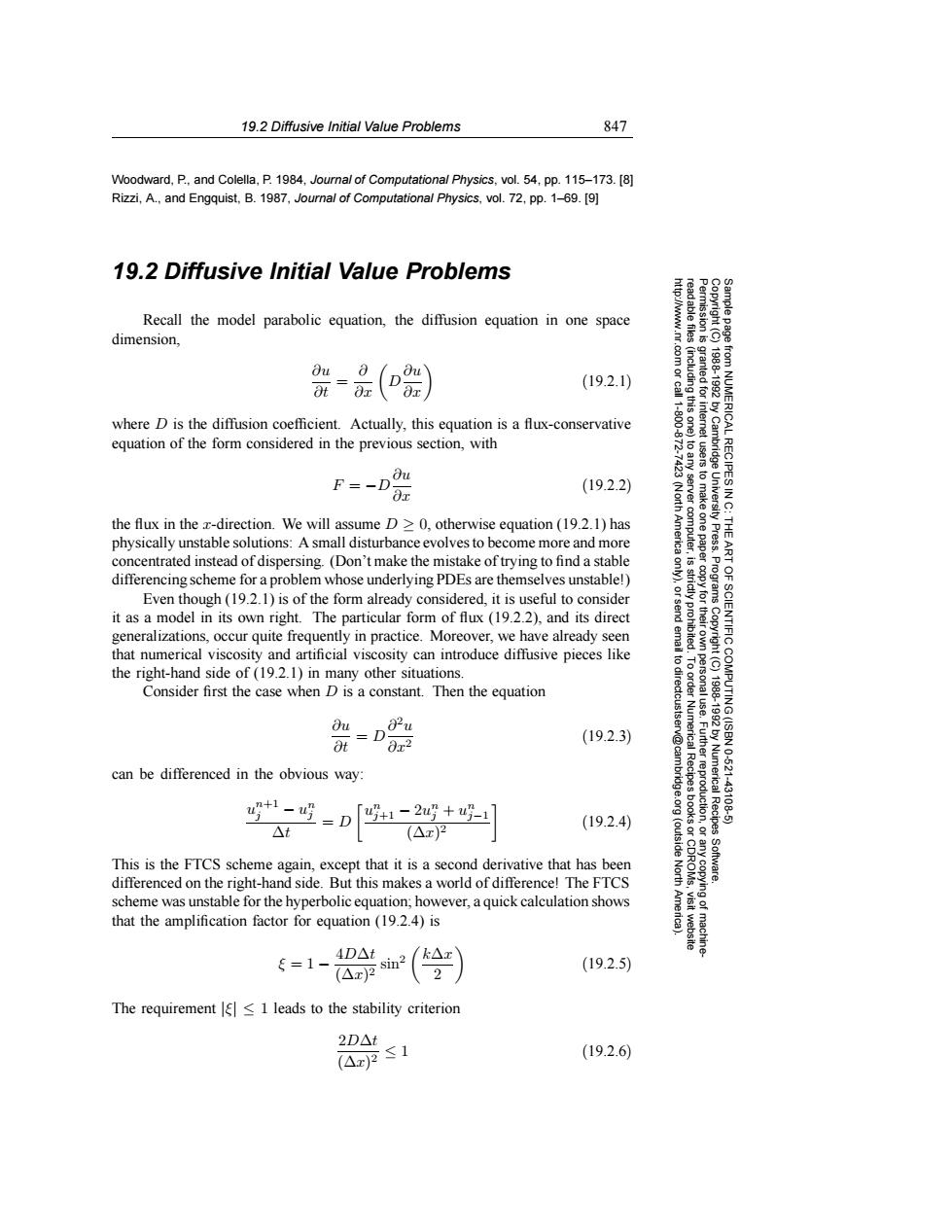正在加载图片...

19.2 Diffusive Initial Value Problems 847 Woodward,P.,and Colella,P.1984,Journal of Computational Physics,vol.54,pp.115-173.[8] Rizzi,A..and Engquist,B.1987,Journal of Computational Physics,vol.72,pp.1-69.[9] 19.2 Diffusive Initial Value Problems Recall the model parabolic equation,the diffusion equation in one space dimension, Ou Ou .com or D 8t (19.2.1) Ox where D is the diffusion coefficient.Actually,this equation is a flux-conservative equation of the form considered in the previous section,with F=-DOu RECIPES (19.2.2) x 线 2 the flux in the z-direction.We will assume D>0.otherwise equation (19.2.1)has physically unstable solutions:A small disturbance evolves to become more and more Press. concentrated instead of dispersing.(Don't make the mistake of trying to find a stable differencing scheme for a problem whose underlying PDEs are themselves unstable!) Even though(19.2.1)is of the form already considered,it is useful to consider it as a model in its own right.The particular form of flux(19.2.2),and its direct OF SCIENTIFIC( generalizations,occur quite frequently in practice.Moreover,we have already seen that numerical viscosity and artificial viscosity can introduce diffusive pieces like 6 the right-hand side of(19.2.1)in many other situations. Consider first the case when D is a constant.Then the equation Ou 02u COMPUTING (ISBN 1992 di=D9 x2 (19.2.3) can be differenced in the obvious way: Numerical 10521 1- 43108 △t D u+1-2u+u3-1 (19.2.4) 天金 (△x)P (outside Recipes This is the FTCS scheme again,except that it is a second derivative that has been Software. differenced on the right-hand side.But this makes a world of difference!The FTCS North scheme was unstable for the hyperbolic equation;however,a quick calculation shows that the amplification factor for equation(19.2.4)is ξ=1- 4D△t k△ (④x2si2 2 (19.2.5) The requirement<1 leads to the stability criterion 2D△t (④x)Ps1 (19.2.6)19.2 Diffusive Initial Value Problems 847 Permission is granted for internet users to make one paper copy for their own personal use. Further reproduction, or any copyin Copyright (C) 1988-1992 by Cambridge University Press. Programs Copyright (C) 1988-1992 by Numerical Recipes Software. Sample page from NUMERICAL RECIPES IN C: THE ART OF SCIENTIFIC COMPUTING (ISBN 0-521-43108-5) g of machinereadable files (including this one) to any server computer, is strictly prohibited. To order Numerical Recipes books or CDROMs, visit website http://www.nr.com or call 1-800-872-7423 (North America only), or send email to directcustserv@cambridge.org (outside North America). Woodward, P., and Colella, P. 1984, Journal of Computational Physics, vol. 54, pp. 115–173. [8] Rizzi, A., and Engquist, B. 1987, Journal of Computational Physics, vol. 72, pp. 1–69. [9] 19.2 Diffusive Initial Value Problems Recall the model parabolic equation, the diffusion equation in one space dimension, ∂u ∂t = ∂ ∂x D ∂u ∂x (19.2.1) where D is the diffusion coefficient. Actually, this equation is a flux-conservative equation of the form considered in the previous section, with F = −D ∂u ∂x (19.2.2) the flux in the x-direction. We will assume D ≥ 0, otherwise equation (19.2.1) has physically unstable solutions: A small disturbance evolves to become more and more concentrated instead of dispersing. (Don’t make the mistake of trying to find a stable differencing scheme for a problem whose underlying PDEs are themselves unstable!) Even though (19.2.1) is of the form already considered, it is useful to consider it as a model in its own right. The particular form of flux (19.2.2), and its direct generalizations, occur quite frequently in practice. Moreover, we have already seen that numerical viscosity and artificial viscosity can introduce diffusive pieces like the right-hand side of (19.2.1) in many other situations. Consider first the case when D is a constant. Then the equation ∂u ∂t = D ∂2u ∂x2 (19.2.3) can be differenced in the obvious way: un+1 j − un j ∆t = D un j+1 − 2un j + un j−1 (∆x)2 (19.2.4) This is the FTCS scheme again, except that it is a second derivative that has been differenced on the right-hand side. But this makes a world of difference! The FTCS scheme was unstable for the hyperbolic equation; however, a quick calculation shows that the amplification factor for equation (19.2.4) is ξ = 1 − 4D∆t (∆x)2 sin2 k∆x 2 (19.2.5) The requirement |ξ| ≤ 1 leads to the stability criterion 2D∆t (∆x)2 ≤ 1 (19.2.6)��